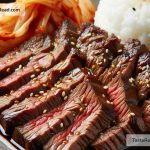How the Korean Kimchi Became a Cultural Icon
In a world where food is as much about sharing culture as it is about sustenance, one dish from the Korean peninsula has crossed borders and become a global phenomenon: Kimchi. This spicy, fermented vegetable dish, primarily made from cabbage and radishes, has a history that stretches back centuries and has become synonymous not only with Korean cuisine but also with the nation’s cultural identity. So, how did Kimchi transform from a local staple into a global culinary icon? Let’s dive into the rich history and significance of this vibrant dish.
Kimchi’s journey begins in the era before refrigeration when fermenting food was one of the best methods to preserve it. The history of Kimchi dates back to around the 7th century. Initially, it was a simple way to save vegetables for the winter months. However, with the introduction of chili peppers into Korea in the late 16th century, Kimchi began to take on its distinctive fiery taste that we know and love today.
Over the centuries, Kimchi evolved with the Korean people, becoming more than just a food item; it became a cultural symbol. Its significance in Korean culture cannot be overstated. It’s not just a side dish served with every meal; it’s a part of Korea’s soul. It’s deeply integrated into the lives of the Korean people, with different regions developing their own unique versions based on local ingredients and tastes. This variety shows the adaptability and diversity within Korean culture itself.
The process of making Kimchi, known as “Kimjang,” is a time-honored tradition that brings families and communities together. During the late fall, people gather to prepare large quantities of Kimchi to last through the winter months. This communal activity is not just about food preparation; it’s a cultural ritual that strengthens bonds and passes down generational knowledge and culture.
Kimchi’s ascent to global fame can be attributed to the rise of Korean culture (often referred to as the “Korean Wave”) around the world. With the increasing popularity of Korean dramas, music, and beauty products, people everywhere became curious about Korean cuisine. Dishes like Kimbap, Bibimbap, and, of course, Kimchi started to appear on menus across the globe. Moreover, the health benefits associated with Kimchi, such as its probiotics, vitamins, and minerals, have captivated health-conscious consumers worldwide.
The allure of Kimchi goes beyond taste and health; it’s about the story it tells and the cultural pride it carries. It represents the essence of Korean tradition, survival, and adaptability. In recognition of its cultural significance, Kimjang, the making and sharing of Kimchi, was added to UNESCO’s Representative List of the Intangible Cultural Heritage of Humanity in 2013. This acknowledgment highlights not just the dish itself but the communal spirit and heritage behind it.
Today, Kimchi is celebrated globally, not just in Korean restaurants but as a gourmet ingredient in many fusion cuisines. Chefs around the world experiment with its unique flavor profile, adding a Korean twist to familiar dishes. From Kimchi burgers to Kimchi tacos, this versatile dish has found its way into the hearts (and stomachs) of people from diverse cultural backgrounds.
Kimchi’s journey from a traditional Korean staple to a global cultural icon is a testament to the power of food in bridging cultural divides. It’s fascinating to see how a simple method of preserving vegetables has transformed into a culinary symbol celebrated worldwide. This spicy, tangy, and slightly sweet dish carries the essence of Korean culture, presenting it to the world on a plate.
The global embrace of Kimchi reflects a broader acceptance and appreciation of Korean culture. It’s more than just a food trend; it’s a symbol of cultural exchange and mutual respect. As we enjoy the rich flavors of Kimchi, we also savor the history, tradition, and community spirit it embodies. Kimchi isn’t just food; it’s a cultural icon, a bridge connecting Korea to the world, and a vibrant reminder of the joy and unity food can bring to our lives.

